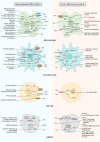Amino acid metabolism in immune cells: essential regulators of the effector functions, and promising opportunities to enhance cancer immunotherapy
- PMID: 37277776
- PMCID: PMC10240810
- DOI: 10.1186/s13045-023-01453-1
Amino acid metabolism in immune cells: essential regulators of the effector functions, and promising opportunities to enhance cancer immunotherapy
Abstract
Amino acids are basic nutrients for immune cells during organ development, tissue homeostasis, and the immune response. Regarding metabolic reprogramming in the tumor microenvironment, dysregulation of amino acid consumption in immune cells is an important underlying mechanism leading to impaired anti-tumor immunity. Emerging studies have revealed that altered amino acid metabolism is tightly linked to tumor outgrowth, metastasis, and therapeutic resistance through governing the fate of various immune cells. During these processes, the concentration of free amino acids, their membrane bound transporters, key metabolic enzymes, and sensors such as mTOR and GCN2 play critical roles in controlling immune cell differentiation and function. As such, anti-cancer immune responses could be enhanced by supplement of specific essential amino acids, or targeting the metabolic enzymes or their sensors, thereby developing novel adjuvant immune therapeutic modalities. To further dissect metabolic regulation of anti-tumor immunity, this review summarizes the regulatory mechanisms governing reprogramming of amino acid metabolism and their effects on the phenotypes and functions of tumor-infiltrating immune cells to propose novel approaches that could be exploited to rewire amino acid metabolism and enhance cancer immunotherapy.
Keywords: Amino acids; Immune cells; SLC transporters; Tumor microenvironment; mTOR.
© 2023. The Author(s).
Conflict of interest statement
The authors have declared no potential conflicts of interest in this review.
Figures




Similar articles
-
Targeting SLC1A5 and SLC3A2/SLC7A5 as a Potential Strategy to Strengthen Anti-Tumor Immunity in the Tumor Microenvironment.Front Immunol. 2021 Apr 19;12:624324. doi: 10.3389/fimmu.2021.624324. eCollection 2021. Front Immunol. 2021. PMID: 33953707 Free PMC article. Review.
-
Amino acid metabolism reprogramming: shedding new light on T cell anti-tumor immunity.J Exp Clin Cancer Res. 2023 Nov 3;42(1):291. doi: 10.1186/s13046-023-02845-4. J Exp Clin Cancer Res. 2023. PMID: 37924140 Free PMC article. Review.
-
The significant role of amino acid metabolic reprogramming in cancer.Cell Commun Signal. 2024 Jul 29;22(1):380. doi: 10.1186/s12964-024-01760-1. Cell Commun Signal. 2024. PMID: 39069612 Free PMC article. Review.
-
Amino Acids and Their Transporters in T Cell Immunity and Cancer Therapy.Mol Cell. 2020 Nov 5;80(3):384-395. doi: 10.1016/j.molcel.2020.09.006. Epub 2020 Sep 29. Mol Cell. 2020. PMID: 32997964 Free PMC article. Review.
-
Metabolic reprogramming in tumor immune microenvironment: Impact on immune cell function and therapeutic implications.Cancer Lett. 2024 Aug 10;597:217076. doi: 10.1016/j.canlet.2024.217076. Epub 2024 Jun 19. Cancer Lett. 2024. PMID: 38906524 Review.
Cited by
-
Impaired arginine/ornithine metabolism drives severe HFMD by promoting cytokine storm.Front Immunol. 2024 Jun 24;15:1407035. doi: 10.3389/fimmu.2024.1407035. eCollection 2024. Front Immunol. 2024. PMID: 38979420 Free PMC article.
-
Multi-omics landscape of childhood simple obesity: novel insights into pathogenesis and biomarkers discovery.Cell Biosci. 2024 Nov 28;14(1):145. doi: 10.1186/s13578-024-01322-5. Cell Biosci. 2024. PMID: 39609876 Free PMC article.
-
Metabolic reprogramming in lung cancer and its clinical implication.Front Pharmacol. 2024 Dec 18;15:1516650. doi: 10.3389/fphar.2024.1516650. eCollection 2024. Front Pharmacol. 2024. PMID: 39744129 Free PMC article. Review.
-
Machine learning-based identification and validation of amino acid metabolism related genes as novel biomarkers in chronic kidney disease.Heliyon. 2025 Jan 10;11(2):e41872. doi: 10.1016/j.heliyon.2025.e41872. eCollection 2025 Jan 30. Heliyon. 2025. PMID: 39897884 Free PMC article.
-
Aromatic Amino Acid Metabolites: Molecular Messengers Bridging Immune-Microbiota Communication.Immune Netw. 2025 Feb 14;25(1):e10. doi: 10.4110/in.2025.25.e10. eCollection 2025 Feb. Immune Netw. 2025. PMID: 40078785 Free PMC article. Review.
References
-
- Roy DG, Kaymak I, Williams KS, Ma EH, Jones RG. Immunometabolism in the tumor microenvironment. Ann Rev Cancer Biol. 2021;5:137–159. doi: 10.1146/annurev-cancerbio-030518-055817. - DOI
Publication types
MeSH terms
Substances
LinkOut - more resources
Full Text Sources
Medical
Research Materials
Miscellaneous

